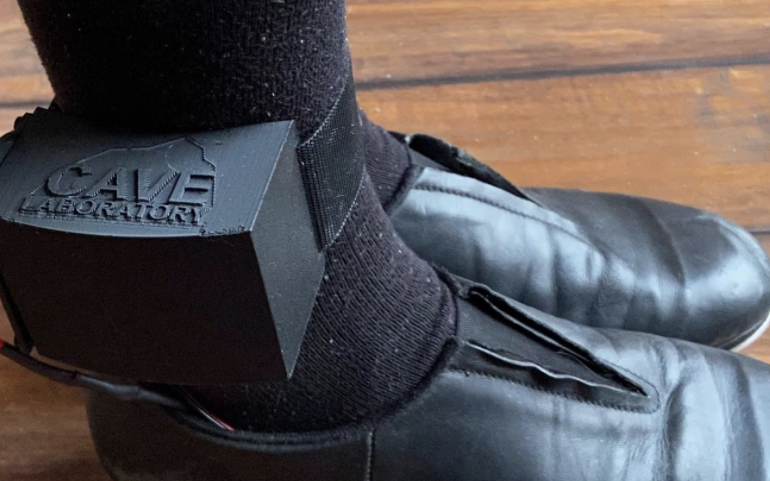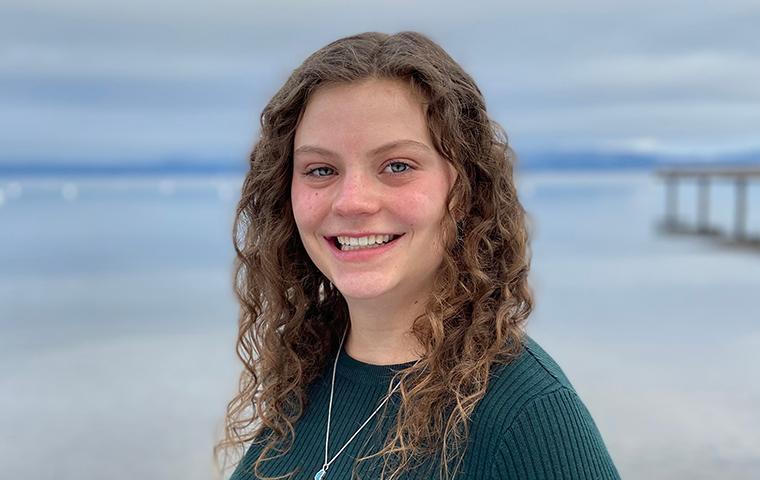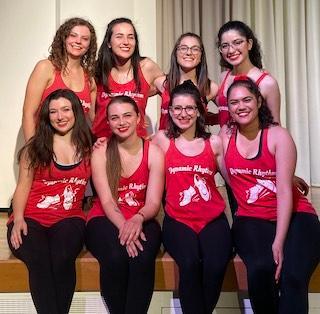
Tap Dance Revolution
Math major Alissa LaFerriere ’21 works on University-led innovation that helps dancers to remember their steps.
Alissa LaFerriere ’21 believes her two greatest passions in life—math and tap dancing—have a lot in common.
“They’re both kind of like solving puzzles,” says the Santa Clara senior, who graduates this week. “How do I put this dance together with this song, and how do I put this proof together to solve this math problem?”
That kind of creative thinking is what caught the attention of a clever SCU faculty member who asked LaFerriere to combine her love of calculations and choreography to help refine SwingBeats, a dance training product his students had been working on since 2019.
“I never thought I would do research,” says LaFerriere, who minored in Computer Science and Urban Education. But when Navid Shaghaghi, a popular lecturer and researcher in math, computer science, engineering, and bioengineering, invited her to join two computer science majors working on the innovation, she jumped right in.
“I had taken one of Navid’s classes, and they knew I had been involved with math and computer science,” recalls LaFerriere, who went on to take three more of his courses after signing onto the project.
Critically, Shaghaghi also knew about Dynamic Rhythm, a tap dancing team LaFerriere had co-founded at SCU in 2018 with Ashley Costa ’19, MS Education ’20. Until COVID-19, the eight-member team, dressed in their distinctive black leggings and red tops, had performed at events around campus. (During the pandemic, they practiced on their own, or together via Zoom, and managed to stage a few Zoom performances based on her choreography.)
SwingBeats intrigued LaFerriere because it’s a real-time haptic feedback system that helps users learn to dance. The lightweight ankle bracelets feature wires that vibrate on a dancer’s toe or heel, signaling when to use that part of their foot without the need to keep constant track of the music’s beat pattern.
The device works by connecting to an app that plays the music and sends the corresponding vibrations to the bracelet. The current model is best for tap dancing, she says, but can also be adapted to other styles of dance.
Building a better ankle bracelet
For Yu Yang Chee ’21 and Jesse Mayer, MS Computer Science and Engineering ’21, the research and development team most recently involved in SwingBeats, LaFerriere’s dance expertise and math background could help them start building the device.

As the team notes in an online video presentation, keeping track of timing is hard; four percent of the world’s population (300 million people) is incapable of hearing beats at all.
SwingBeats is designed to overcome that by triggering the movement of the feet in accordance with the programmed choreography that's in sync with the beat of the music. Its Velcro bracelet circuitry centers around a chip integrated with Wi-Fi and Bluetooth connectivity and includes vibration motors connected to actuator wires placed on the toe and heel. Each bracelet’s 3D printed box contains a rechargeable battery, charging apparatus, and on-off push button.
To begin, the dancer turns on the device, and opens the supporting mobile app. After turning on the app, it authenticates with Spotify, and connects with the hardware via Bluetooth. The dancer selects the song he or she wants, and the app sends dance instructions to the hardware. The dancer then presses start on the app, which tells the device to start vibrating.
A dancer’s insights
LaFerriere’s testing (along with members of Dynamic Rhythm) led the team to program the device to vibrate not right when a dancer steps, but 100 milliseconds beforehand, so that the dancer's brain has some time to process which foot he or she should use. She also encouraged her colleagues to create a light vibration to tell a dancer to tap their foot, while a stronger vibration means he or she should step onto their foot.
“Tap dancing is pure happiness—you get to do so many cool little things with your feet,” says LaFerriere, who started dancing at age three, and tap dancing at age six. “It’s a nice stress reliever from school.”
From its earliest inception, SwingBeats has garnered attention. It won the “creativity theme” category at SCU’s 2019 Hack for Humanity, and team members are working with the Ciocca Center's Bronco Venture Accelerator program to attract investors and bring it to market. Most recently, Chee, Mayer and LaFerriere were awarded best technical paper and second overall at EAI Intetain 2020, an international conference on intelligent technologies for interactive entertainment.
Further R&D is underway, and the team hopes to design the device to record dancers' movements using a combination of sensors. That could help the dancer and his or her teacher review precisely where the dancer is faltering during a routine. SwingBeats would likely be marketed first to dance studios, says LaFerriere, and perhaps sold with an online subscription for access to recorded dance feedback. A virtual reality component is also being developed that would allow dancers wearing SwingBeats to dance with others.
An early peek at Santa Clara
LaFerriere's Bronco journey actually began as a high schooler, when the math enthusiast enrolled in a summer academic camp at SCU. She enjoyed the experience so much that later, when Chapman University and Santa Clara offered her scholarships, LaFerriere remembers telling her mother that SCU “feels like the place I’m supposed to be.”

The first in her Tahoe City-based family to graduate from college, LaFerriere received the DaRin Butz Foundation Scholarship, awarded to top female math or computer science majors at Santa Clara. (She just wrapped up her term as president of SCU’s Association for Women in Mathematics, and president of its chapter of Pi Mu Epsilon, the national mathematics society.)
Her passion for math is also what drives her career goal to teach math to underprivileged teenagers, and this summer she heads to Stanford University to start a one-year master’s program in education that includes a teaching degree. But she'll continue working with SwingBeats, leading the team to refine and expand its uses, as well as participating in marketing and financial strategies, including pitching to investors.
“I never thought I would be doing all this different stuff, and that’s why I love Santa Clara so much,” says LaFerriere of her time at SCU. “I got so many amazing opportunities through this university, and made so many amazing connections with both peers and faculty who have really guided me along,” she recalls.
“The biggest thing I’ve learned is what I’m passionate about, and how much I can accomplish if I give it my all.”